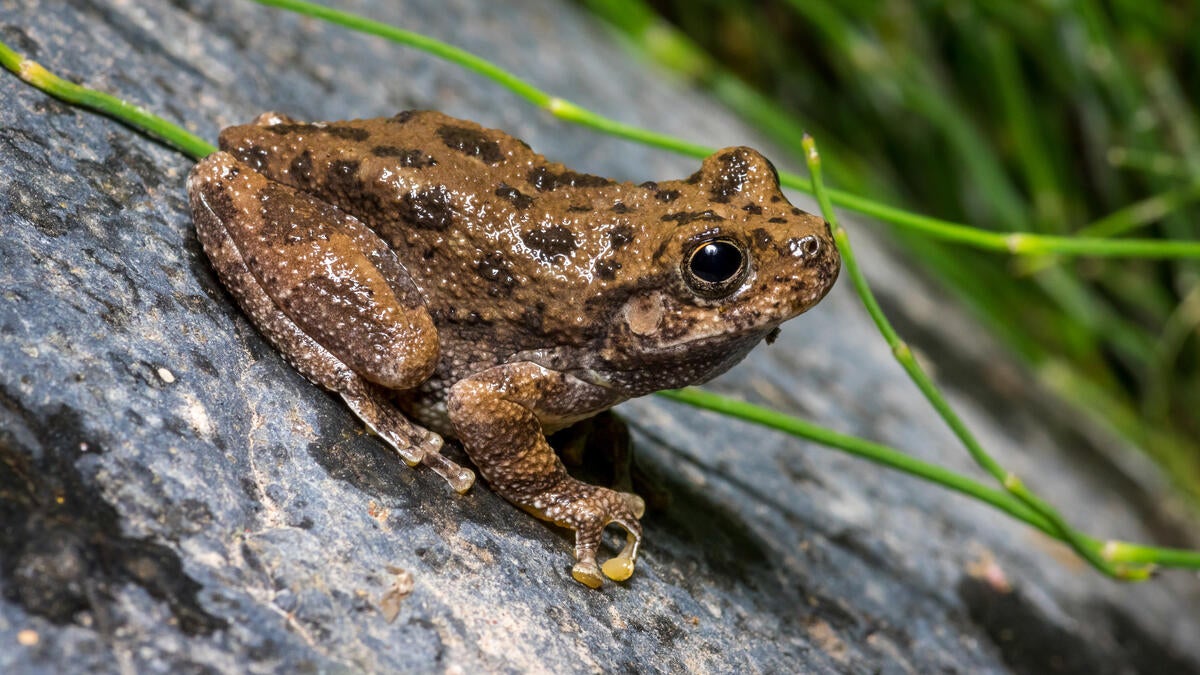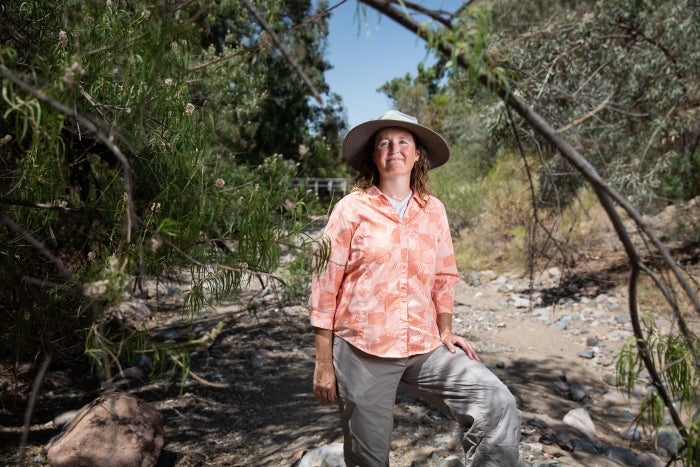Study looks at impact of spring flooding on canyon tree frogs

The canyon tree frog's mating habits coincide with spring flooding along the Verde River. Photo by Timothy Cota/iStock
The life history of a canyon tree frog — a species of tree frog that can be found in the rocky plateau areas of Arizona — may not seem significant to the average person.
But Heather Bateman, a professor in Arizona State University’s College of Integrative Sciences and Arts, sees it differently.
“There’s so many myths about these organisms, like they’re not very interesting or worthy (of study),” said Bateman, who is also a senior Global Futures scientist. “Anything I can do to dispel that is my mission.”
That’s one reason Bateman, along with student researcher and alumni Maggie Huck, who graduated last December with a master’s degree in applied biological sciences in the School of Applied Sciences and Arts, co-authored an article focusing on amphibian breeding — specifically the canyon tree frog (Hyla arenicolor) — as it relates to stream flow, habitat structure and sustaining biodiversity.
The species is known to be vulnerable to climate change and other habitat changes, so understanding its mating habits demonstrates the important connection between hydrology and biology.
ASU News talked to Bateman about the paper, which was recently published in the journal Ecology, to learn more about its implications.
I hope (people) understand that this is such an amazing system that we have in our backyard.
Heather BatemanProfessor, College of Integrative Sciences and Arts
Editor's note: The following interview has been edited for length and clarity.
Question: Can you give an overview of the paper?
Answer: We worked in the Verde River system, which comes into the Salt River. It’s Phoenix water. And the headwater streams are in wilderness areas on forest service (public) land. But there’s also a proverbial patchwork of ownership. Our goal was tying natural resources to hydrologic flows. How do these canyon-bound streams influence the natural resources? Our ultimate goal really is to provide the evidence and justification for the outstanding natural values of the Verde River system. We’re just building the body of evidence saying how critical these areas are for natural resources.
Q: What did you find in your study?
A: We found that the timing of canyon tree frog breeding behavior coincided with spring floods. All of the snowpack that has fallen in Flagstaff and the high country, when it starts melting, it comes into these headwater streams and the streams pulse up in flow. In a short matter of days, streams flood. And then the flooding recedes. In a very short window after that, like a week to two weeks, the canyon tree frogs start calling and commencing their breeding activities. So they’re really tied into those spring floods.
Q: Why is it important to study the frogs’ mating habits and how they’re tied into stream flows?
A: We’re pretty much in the heart of the canyon tree frog geographical range. It’s not a rare species, but it is a species that has been deemed vulnerable to things like climate change or anything that could affect stream flow.
Q: How vulnerable is the species?
A: They’re very common, but because of the habitat they’re found in, they’re very much tied to these canyon-bound streams and perennial flows.
That’s the other thing. These perennial systems in the Southwest are rare. So if there’s anything that going’s to (cause) reducing flows in streams, whether it’s from climate change or groundwater pumping … humans make decisions about water all the time. Sometimes, I think some of these decisions are built around, “When could the river produce an excess of water?” And sometimes floods are targeted, like, “Hey, let’s take the flooding out of the system.” So seeing how that flooding is important for the breeding phenology is interesting.
Q: Is it fair to assume these frogs aren’t the only species that need these flood pulses?
A: It’s been long documented that native fishes have this same pattern. So we were kind of borrowing some similar lines of evidence that a lot of the desert fishes, the native desert fishes, require flooding for spawning. It’s really important.
Deanna Dent/ASU
Q: If those spring flows are redirected away from streams, what might happen to the organisms that depend on these pulses?
A: We already know that some organisms require these floods to persist. For example, native fish spawn on the falling limb of spring floods, and these scouring spring floods are what cottonwood trees need for recruitment (set seeds to establish and grow). There are likely many other organisms that require these floods and we haven’t studied them in detail to fully understand yet. Although our findings that canyon treefrogs (like fish) commence breeding activity after spring floods isn’t altogether a surprise, it does show this important connection between hydrology and biology that isn’t easy to document.
Q: It sounds like the point of the paper is to show how climate change or man-made attempts to regulate water flow could impact all these different species along the Verde River.
A: That’s the implication. But I think the point is being able to tie both the physical environment and the biologic environment, because that’s hard to do. It’s very interdisciplinary. We had to work with geomorphologists and hydrologists to co-locate the water measurements with frog measurements. The goal is to have this picture of both the physical and biological aspects of these stream systems. Or, simply, how do we tie the organisms, the wildlife, to the stream flows?
Q: What do you hope is the takeaway for people when they read the paper?
A: I hope they understand that this is such an amazing system that we have in our backyard. We know these places are special because where do you go in the heat of the summer? You look for water. And you look for shade. These places are just the most biologically rich environments we have in the state. So they’re very important.
Q: And we need to preserve them.
A: Absolutely.
More Environment and sustainability

Saving the environment to save ourselves
Saving the environment.At Arizona State University, that's not just a trendy slogan. From water insecurity to wildfire awareness to cleaning pollutants in urban fishing waterways, ASU is…

A sea change regarding our ocean
By Marshall Terrill and Joe Rojas-BurkeThe ocean matters more than most of us may realize.Our seas offer soothing scenes for millions of vacationers. They provide seafood for our tables. They are a…

'Earth Day Amplified' promotes power of collective action
Everybody loves the concept of sustainability. They want to do their part, and the chance to say they’ve contributed to the well-being our of planet.But what does that actually mean?Arizona State…


